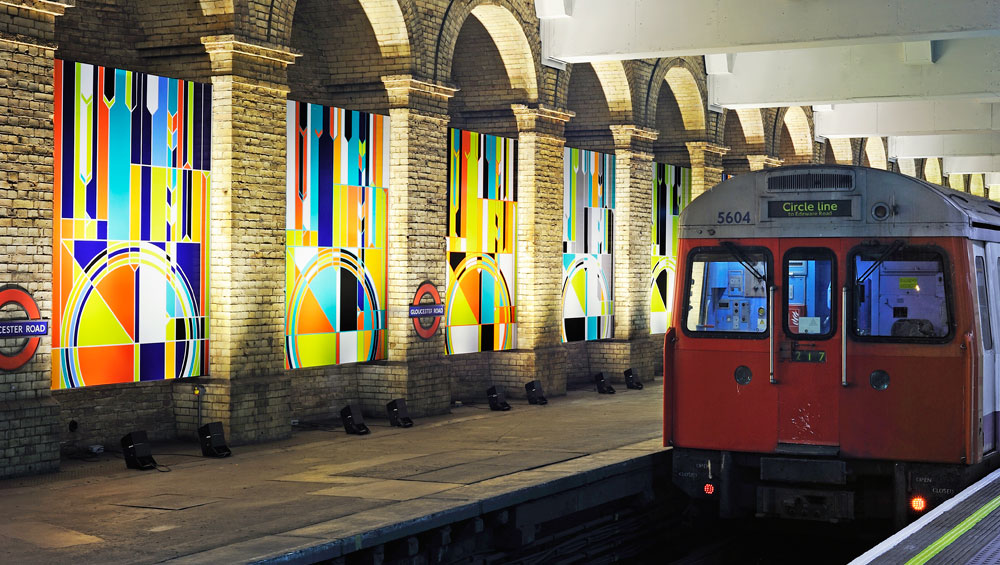
by VERONICA SIMPSON
Art on the Underground has an audience beyond the reach of any gallery - five million passengers every day – and 270 stations across London’s tube network in which to display work. Yet, despite its vast reach and the fact that it has commissioned artists including Cindy Sherman, David Shrigley, Mark Titchner, David Batchelor and Assemble, few people outside the art world have heard of it.
Heather Phillipson, my name is lettie eggsyrub, 2018
Its programme for 2018-19 kicks off this summer with an immersive new multimedia work by Heather Phillipson (b1978) at Gloucester Road station, where a disused platform has become a permanent display space for three-dimensional art. Phillipson is one of an impressive lineup of established and emerging female artists of many ages and nationalities selected to mark the centenary year of the Representation of the People Act (whereby all men and some women over the age of 30 were granted the vote).
Later in the year, a new print work from Romania’s Geta Brătescu (b1926) – her first public commission in the UK – will feature on the cover of 25m copies of the pocket tube map, and a new billboard commission by post-punk, feminist British artist Linder (b1954) will appear at Southwark station.
Two emerging artists have also been commissioned: France’s Marie Jacotey (b1988) will produce a cover for the night tube map, and Nigerian-born, Los Angeles-based Njideka Akunyili Crosby (b1983) is making a photo-collage work at Brixton station. Artist and sociologist Nina Wakeford (b1968) is undertaking a two-year residency around stations on the Northern line extension (new stations are being built at Nine Elms and Battersea Power Station), which will result in new work that reflects these changing social and urban environments.
.jpg)
Marie Jacotey. You in my bedroom, 2018. Photograph: Benedict Johnson.2018.
Eleanor Pinfield joined Art on the Underground in 2014, coming from Tate, taking over from then director Tamsin Dillon. She relishes the opportunity to engage with a demographic that most galleries are crying out to attract – not the affluent, white and elderly but the everyday, hard-working civilians of all ages and ethnicities.
Here, she discusses the role of art within infrastructure (only New York has a programme of a similar calibre to the one in London); how the programme has evolved, and how she has made the most of opportunities to disperse a range of print, film, installation and photography works in front of bored commuters in a way that can enrich and enliven their journeys.
Veronica Simpson: There is obviously a huge amount of trust and confidence between the Art on the Underground team and its parent organisation Transport for London (TfL). You are part of a permanent team of four curatorial staff. Can you tell me how the programme originated and how that relationship has evolved?
Eleanor Pinfield: It was initiated as a community arts project, and as a single project in Gloucester Road station, which has a disused platform. It started out with letting students come in and use the space.
VS: The work with Cindy Sherman really grabbed people’s attention. [In 2003, Sherman’s first billboard project at Gloucester Road, Billboard Commission, was a collaboration with the Serpentine Gallery, which ran an exhibition of Sherman’s work concurrently.]
EP: Yes, Tamsin Dillon took over as curator and then became head of the programme around 2004, but I know she did the Serpentine project with Cindy Sherman. In that period, it was really gearing up to be a world-class space of art display. It was in some ways an exhibition-led model, in that it was asking artists to use it as a very situated environment, a space of display.
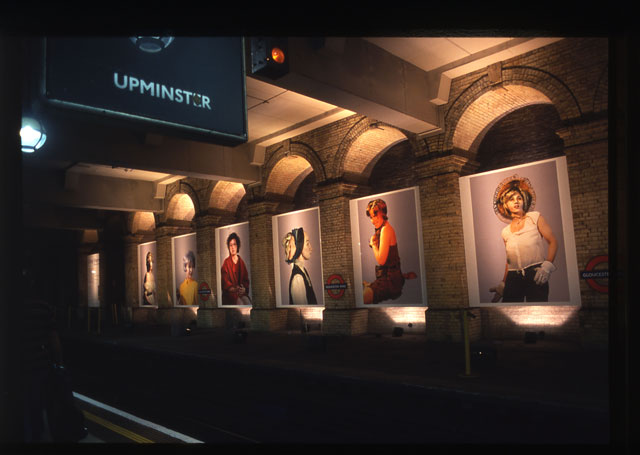
Cindy Sherman, for Art on the Underground, Gloucester Road station, London, 3 June – 8 September 2003. Photograph: Stephen White.
Cindy Sherman was a real game-changing moment, though; such a high-profile artist. Then there was early work in 2005 of David Batchelor, then we had David Shrigley, Mark Titchner, really great projects. I’m now assuming, looking back, that those were the stepping stones to building trust within the organisation, to show what could happen, how exciting it could be and to take it wider.
Then, in 2009 and 2011, new permanent works commissioned from Knut Henrik Henriksen were installed at King’s Cross. That was seizing the opportunity of a new tube station and those two works were the first permanent works to have been commissioned since the 1980s and Eduardo Paolozzi [an iconic mural at Tottenham Court Road]. If you look back, there are ebbs and flows, from that exciting period in the 80s through lots of architectural investment with new tube stations in the 90s.
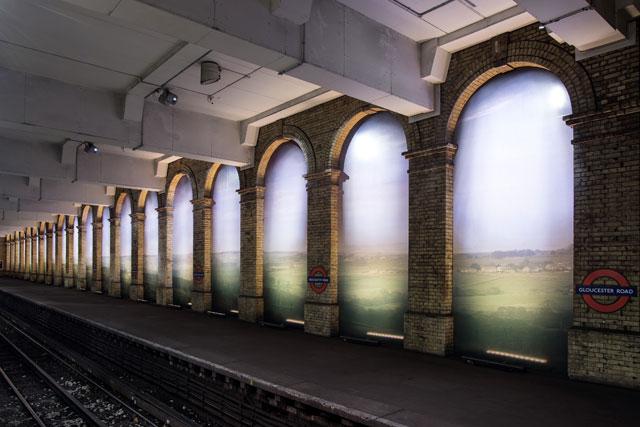
Trevor Paglen. An English Landscape (American Surveillance Base near Harrogate, Yorkshire), for Art on the Underground, Gloucester Road station, London, 15 June 2014 – 13 July 2016. Photograph: Thierry Bal.
VS: Then after Henriksen, there was Jacqui Poncelet’s work Wrapper at Edgware Road, and John Maine’s Sea Strata at Green Park station. And other sites have developed along with Gloucester Road, for regular reprogramming.
EP: There are six sites that we reprogramme now, including Stratford station, which was an important one in the run up to the 2012 Summer Olympics, and we used that site to do a lot of work with local communities. There’s now Southwark station, where we have temporary billboards around the lovely Richard MacCormac-designed station. One day, I assume that site will get developed, but for now it is a great billboard for us. So, we have those fixed sites. And in the early days, the programme had its line series, which could move around the city, challenging us to think about how to bring an artwork everywhere, not just focus it in single locations. In about 2004, there was an initiative to commission artworks for the front of the pocket tube map, which is such a simple idea, and such a powerful one. We now have Geta producing our 28th cover. It’s a really rich series with such incredible artists, who have tended to be the big names, the established artists, so when the night tube started (in 2016), we thought we want to work with emerging-level, London-based artists.
VS: The Labyrinth work with Mark Wallinger marked a different way of embedding small permanent works into many stations.
EP: Yes, that was done in 2013, really questioning what permanent means – but small scale. There are 270 of Mark’s artworks on the (different) London Underground stations, and that, I think, is an amazing example of public work. It has so truly been adopted into the fabric of London. We have some wonderful obsessives who tweet us every weekend – they go and hunt them all down; they photograph them all. If someone has stuck a sticker on one, they tell us. There’s a sense of true ownership, which I think is quite rare with public works.
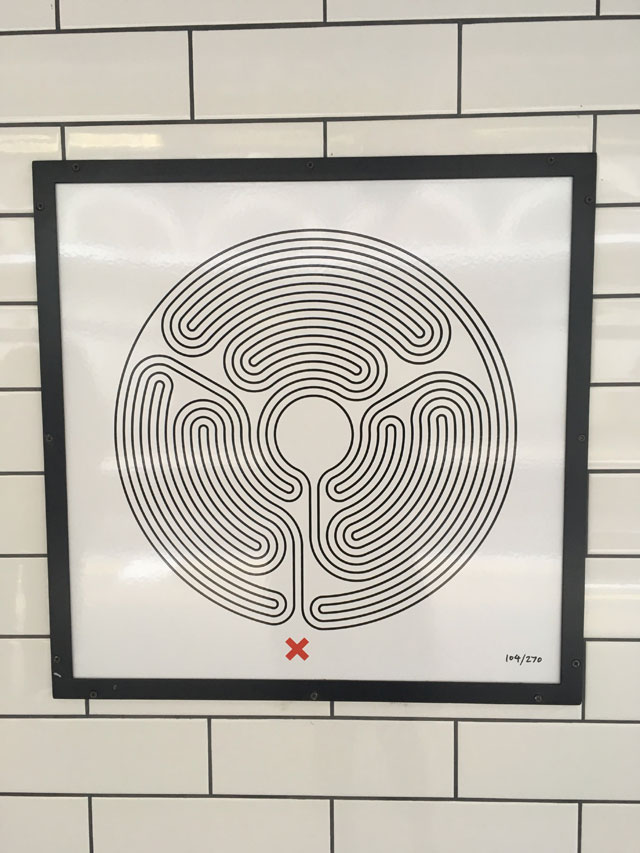
Mark Wallinger, Labyrinth (one of the 270 individual artworks). Photograph: Veronica Simpson.
Since I took over in 2014, I’ve been thinking about how we create variety; how do we fully engage with contemporary art practice to gain the most exciting outcomes for our massive audience? We commissioned [the collective] Assemble in late 2014, before the Turner Prize win, which was obviously great. But they were part of the permanent works we planned for the Victoria line, which really riffed off those ideas of decentring our programme to bring it all over the city.
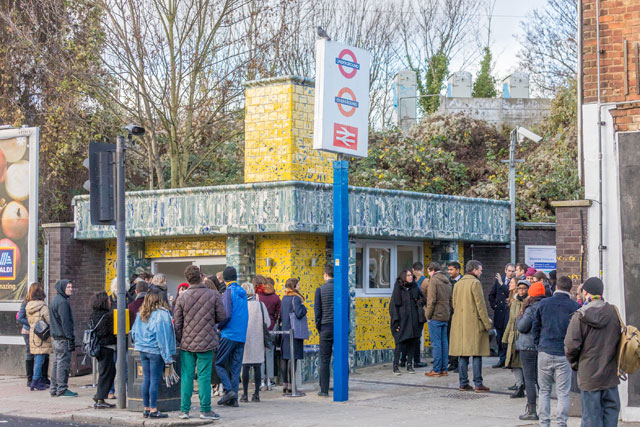
Assemble and Matthew Raw, Clay Station, for Art on the Underground, London, 2017. Photograph: Benedict Johnson.
We worked with Giles Round, who created a series of tiles that we have managed to put up in three different stations, trying to fit into the existing fabric of those stations. You can see that at Victoria, at Blackhorse Road and at Vauxhall. He very much references the history of the underground in terms of the colour palette used – the Victoria line’s signature blue - and the history of the 1960s design of the Victoria line, a deep exploration of that visual culture. Liam Gillick did a series of video works for that programme. And we commissioned a composer for the first time: Matt Rogers worked with the London Sinfonietta to provide some music … Zineb Sedira did a series of film projects.
VS: The Assemble project [at Seven Sisters station] is an exciting opportunity to enhance both the physical fabric and facilities at a station, given that it refurbishes a semi-derelict retail kiosk.
EP: Assemble worked with Matthew Raw, the ceramics artist, making the most beautiful tiles. He has a really scientific approach, about embedding dyes through the whole fabric of the clay. It’s not a glaze, and the richness of the colours, the jewel-like natural tones fit into that environment in a way that’s quite phenomenal. Assemble is a really big one we were proud to launch last year. There were apprenticeships tied into that, with two youngish people – between 18 and 22 - who worked with Matthew quite closely. We worked with [Barbican-based arts agency] Create London to make that happen. That’s part of our reassessment of what a public art role is and how we engage with programmes.
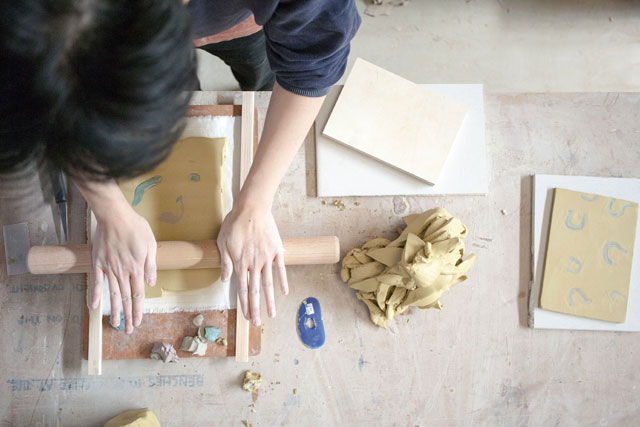
Assemble and Matthew Raw, Clay Station, for Art on the Underground, London, 2017. Photograph: Benedict Johnson.
This goes back to your question of why TfL supports these art projects: it’s to make us think about the city in a different way, to make us see transport as what we know it to be, which is absolutely embedded into the life of the city. But it’s also to make people feel their ownership of the station. If we can bring people in and they are meeting station staff and getting involved with local cultural organisations around them … It’s completely humanising what can sometimes feel like an inhuman system. These activities that can support communities have a real long-term legacy beyond the moment in which they happen.
VS: Given the greater long-term impact of something structural and permanent on the general public, and the success of Assemble’s project and Jacqui Poncelet’s Wrapper (a permanent work to clad the new building and perimeter wall next to Edgware Road station), are you actively looking for more opportunities to embed art permanently at stations?
EP: There’s also the project I completed with Daniel Buren in 2016 – his huge work at Tottenham Court Road, Diamonds and Circles. It’s incredibly slow working on those kinds of projects. It’s incredibly rewarding, as well. So, we are looking at the next pipeline of the next permanent works coming through, either through major station upgrades or through new stations that are being built.
It’s about having the right opportunities to integrate the work in the right way. New stations are really exciting. Big upgrades, where there’s wholesale remodelling or new entrances, they’re potentially equally exciting.
![Sarah Morris. Big Ben [2012], for Art on the Underground, Gloucester Road station, London, 11 June 2012 – 1 September 2013. Photograph: Thierry Bal.](/images/articles/a/083-art-on-underground-2018/SarahMorrisBigBen2012PhotoThierryBal.jpg)
Sarah Morris. Big Ben [2012], for Art on the Underground, Gloucester Road station, London, 11 June 2012 – 1 September 2013. Photograph: Thierry Bal.
VS: One of the things I admire about Art on the Underground is its role in emphasising infrastructure as public space. This means a huge amount, as London’s truly public spaces – owned by local government – are increasingly being sold off, and what we see as public space is often now private.
EP: We are a landowner in one sense, but I would say there is, completely, a democracy to the underground. I am also conscious that the underground is a more expensive form of travel, as opposed to buses. A lot of what we do is street facing within those spaces, so there is a real sense that these spaces matter and how people feel in them matters. It’s essential.
The London Underground has had this long-term focus on good-quality design, which includes art, architecture, signage and staff. I always think that when I go to other cities, because we have such staffed spaces, the human level really comes to the fore.
In terms of contemporary art practice, we have so much power, such potential to speak to so many people through using systems that they are already used to – such as advertising, billboards, print - to challenge and subvert, in a way that enlivens the daily journey.
And we’ve planned this exciting year for 2018. We have been planning this for the past 18 months.
AndyKeate.jpg)
Brian Griffiths. Life is a Laugh, for Art on the Underground, London, 1 July – 31 December 2007. Photograph: Andy Keate.
VS: Yes, it really is “the year of the women”, and you have such an interesting mixture and range, in terms of age, nationality and practice. How did you choose these artists?
EP: We didn’t book any of them because they’re women. We had already identified them as people we wanted to work with, and they all happened to be women. We selected this group to try to bring these different textures and feels to the underground. There is a frustration in the art world about women’s voices, or lack of them, and these are just amazing voices. We don’t give enough time in prestige projects to women’s voices, especially in public art. This is a small nod towards acknowledging that. With Heather Phillipson, Gloucester Road is a large sculptural work, and includes video as well. Our ambition was to work with an artist who wanted to really engage with the three-dimensional possibilities and the length of that space.
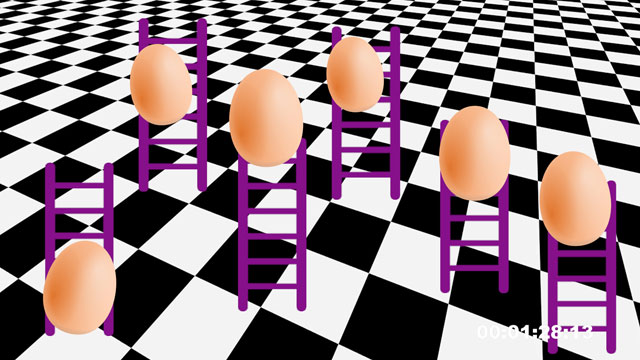
Heather Phillipson, my name is lettie eggsyrub, video still from forthcoming Gloucester Road installation, 2018, commissioned by Art on the Underground.
She has really taken that sense of the sightlines and that 80-metre platform length. In some ways, she’s seeing it like a computer game platform, which I think is a really interesting aesthetic. She’s also brought a light-hearted, aesthetic reference to Chuckie Egg, which was an iconic 80s computer game. With Heather, there’s an oversized joy to what she does, also a kind of urgency, and a socially enlivened reasoning: she’s questioning what we see every day. She’s got the fourth plinth coming up as well, which is a great opportunity for her to get work outside the gallery.
Linder is a fascinating counterpoint. Thinking about the history of British art, the history of British feminist art, Linder plays such a role in that story. She’s also making extremely interesting work, with her collages, the performances and the sense of myth-making she likes. We wanted to think about the forms of getting these messages out, so we gave Linder quite a specific task, to do both a tube map cover and also a billboard. She’s quite architectural as well, so at the moment we’re exploring the architecture.
Njideka Akunyili Crosby is someone we, as a curatorial team, feel is on another level in terms of her collaged paintings. She is getting a huge amount of international interest now. We wanted to bring in a new curatorial strand to Brixton. We’re trying to take a step back and say what does this site mean to the community? So, we started thinking about the environment of Brixton, the murals, the area, an element of nostalgia and that sense of collective identity. So Njideka will make a work that responds to memory-making and how you represent that in figurative forms, which is how her painting collages work. In that location it will be so powerful. We will continue programming that site along those themes, together with some engagement work around making a map, a local mural.
.jpg)
Geta Brătescu. Game of Forms, 2018. Photograph: Benedict Johnson.
Then we have our Geta Brătescu as one of our tube map artists. We approached her in the summer last year, after seeing her work in Venice, and at Camden Arts Centre: the way she works with paper, with drawn line and fabric is so exciting. She was thrilled to take it on. It is her first UK public commission - in her 90s. I think that’s also the power of the London Underground … to have an artwork that will be put in front of so many people. We print 12m maps (for the main map, per artist, with two artists per year). We think it’s one of the most printed commissions, unless you’re on a banknote or a stamp.
Alongside Geta, we are working with Marie Jacotey for the night tube maps. She has made a work with chalks. (Where) Geta is working in abstract forms, Marie is working with capturing intimacies that have formed so much of our lives. And as a younger woman, born in France, living in London, she has created a work with a real sense of interiority, a very personal reflection on the night.
VS: How does TfL articulate the value of the Art in the Underground programme?
EP: To TfL, the most important point is that it is seen that it cares about its customers. We all know you can have a bad journey and your train gets delayed and it doesn’t always feel like that, but that is what it is measuring day in, day out, and we feel we have a very important role in that kind of reputation. The wider activities that TfL does - in terms of its art programme, poetry programme, its communities programme - these things bring massively disproportionate love back to TfL for the amount that’s invested in them. It’s not just about getting you from A to B. It truly feels as though people are interested in you as a human being as you travel. What we can do is add that enriching, exciting, enlivening aspect to people’s journeys.
London – and London Underground - deserve to have the best artists in the world. We are a cultural hub. So that’s exactly where we should be pitching. That’s the London opportunity.